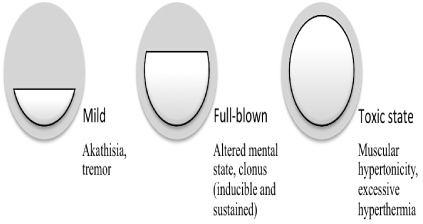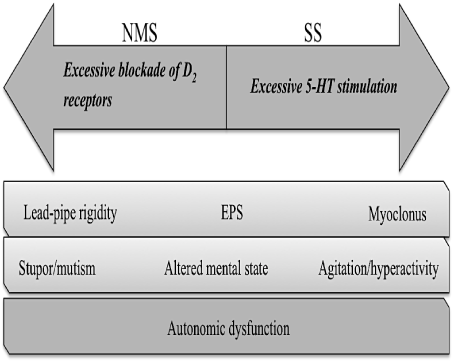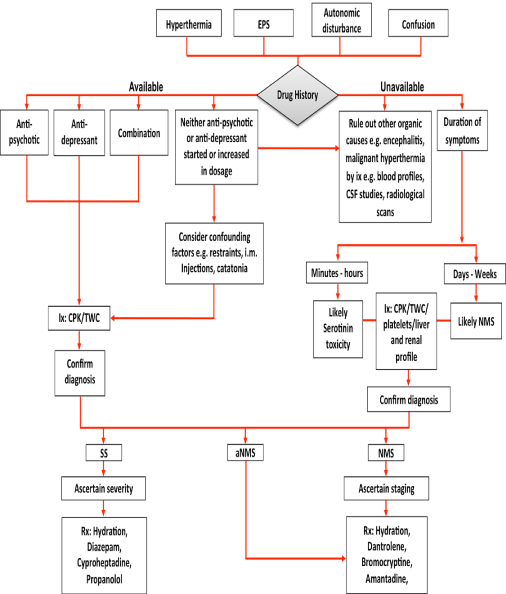
Review Article
Austin J Pharmacol Ther. 2015; 3(2).1072.
An Approach to Diagnosing and Managing Neuroleptic Malignant Syndrome, Atypical Neuroleptic Malignant Syndrome and Serotonin Syndrome using a Flowchart Algorithm
PK Chandrasekaran¹* and GS Grewal²
¹Neurobehavioural Medicine, Penang Adventist Hospital, Malaysia
²Department of Psychiatry, Perdana Graduate School of Medicine, Malaysia
*Corresponding author: : Prem Kumar Chandrasekaran, 465 Burmah Road, Georgetown, Penang 10350, Malaysia
Received: July 16, 2015; Accepted: August 18, 2015; Published: August 27, 2015
Abstract
Background: Increasing co-administration of neuroleptic and antidepressant medications used to treat a variety of psychiatric and medical illnesses can put patients at increased risk of developing iatrogenic adverse drug reactions, including potentially fatal ones such as Neuroleptic Malignant Syndrome (NMS). The reporting of atypical forms of adverse events that do not fulfill the criteria for the diagnosis of NMS have been on the rise, as are varied presentations of Serotonin Toxicity; these have been attributed to drug combinations that may pharmacologically block dopamine and stimulate serotonin receptors, with the typical picture of NMS and frank Serotonin Syndrome (SS) existing on the ends of their respective pathophysiological processes. And the less clinically severe Atypical NMS (aNMS) aligning itself in closer proximity to the NMS portion of the spectrum.
Objective: To propose a simple diagnostic and management flowchart to determine to what extent each process contributes to a given presentation, to detect the likely type of receptor involvement and to suggest paths in the approach to treatment in as flexible a form and most advantageous in outcome. The said algorithm should aid clinicians faced with diagnostic and therapeutic difficulties to critically appraise their patients with these conditions.
Method and Result: A MEDLINE search was performed for case reports, review articles and clinical studies pertaining to NMS, SS and aNMS over a 35- year period from 1980 to 2015. A total of 25 articles were found relevant to this particular manuscript.
Conclusion: Prompt detection and treatment of adverse drug reactions to neuroleptic and antidepressant therapies could halt the progression of NMS, aNMS and SS and reduce their morbidity. An algorithmic management approach should be considered, more especially in the case of NMS, wherein missing such a diagnosis may likely translate to an increased mortality rate.
Keywords: Neuroleptic; Serotonin; Syndrome; Atypical; Algorithm; Abortive; Rechallenge; Mortality
Abbreviations
NMS: Neuroleptic Malignant Syndrome; SS: Serotonin Syndrome; aNMS: Atypical Neuroleptic Malignant Syndrome; EPS: Extrapyramidal Symptoms; CPK: Creatinine Phosphokinase; MAOI: Monoamine Oxidase Inhibitor; SSRI: Selective Serotonin Reuptake Inhibitor; LDH: Lactate Dehydrogenase; ALT: Alanine Aminotransferase; AST: Aspartate Aminotransferase; ECT: Electroconvulsive therapy
Introduction
Neuroleptic malignant syndrome (NMS) is an idiosyncratic drug reaction that is not dose-related [1] and arises from the excessive blockade of dopamine receptors, namely D2, in the basal ganglia and hypothalamus [2]. The clinical features consist of hyperthermia, rigidity or extrapyramidal symptoms (EPS), autonomic disturbances and confusion with stupor or mutism. The onset is sub-acute [3], ranging from days to weeks, but it can progress within 24-72 hours. It consists of 5 stages [4] (Figure 1) and is a diagnosis of exclusion. A neuroleptic should have been started or increased in dosage prior to the onset of signs and symptoms but this phenomenon has also been known to occur after withdrawal of a dopaminergic agonist [5]. The incidence rate of NMS in psychiatric in-patients range from 0.2% to 3.2% [6]. While the severe and fulminant type of NMS is easily recognizable, there is increasing evidence in favor of the existence of a more easily overlooked milder and atypical form of NMS.

Figure 1: Stages of neuroleptic malignant syndrome..
Atypical NMS (aNMS) requires only 3 of the 4 cardinal signs of NMS [5] and is manifested by lead-pipe rigidity, lack of extreme hyperthermia and grossly elevated creatinine phosphokinase (CPK) activity – a phenomenon suggested to be related to muscle damage but not severe enough to cause frank rhabdomyolysis [7]. Elevated CPK levels can exhibit a double peak (bimodal pattern) particularly if in relation to sustained head injury [8]. aNMS has been known to occur with a range of medications, such as antipsychotics, anticonvulsants and antidepressants [9,10].
In contrast to NMS, Serotonin syndrome (SS) is a predictable consequence resulting from excessive stimulation of specific central and peripheral serotonin receptors, especially 5-HT1A and 5-HT2A, known to mediate hypothermia and hyperthermia respectively. Other receptors, such as 5-HT3 and 5-HT4 may also be involved and may affect dopaminergic transmission [3]. The term SS, previously described as an ‘indolamine syndrome’, originated from the serotonin behavioral syndrome observed in rodents and is characterized by myoclonus and agitation/hyperactivity. The onset is sudden and progression is rapid - most cases will resolve in 24 hours after discontinuation of the precipitating drug(s). There are 3 categories of severity [11] (Figure 2) and as with NMS, it is based on exclusion.

Figure 2: Categories of severity in Serotonin Syndrome.
Background
The spectrum
Fink postulated that since acute neurotoxic syndromes such as NMS and SS meet the criteria for catatonia, they are therefore generally subtypes of it [12]. The spectrum of symptoms between these conditions and lethal catatonia, malignant hyperthermia and anticholinergic toxicity has been considered as a malignant cerebrotoxic syndrome [13]. Altered mental status, EPS and autonomic disturbances form the common presentations. However, a ‘catatonic dilemma’ arises when having to differentiate NMS from SS or febrile catatonia [2]. An amalgamative understanding of the pathophysiological backgrounds of these two conditions (Figure 3) [1] provides a better appreciation of why a systematic approach in their management is suggested.

Figure 3: Malignant Cerebrotoxic Syndrome.
Although aNMS traverses the spectrum between NMS and SS, many cases would still not receive a diagnosis of NMS if the rather stringent diagnostic criteria in the DSM-V are adhered to, i.e. severe muscle rigidity and hyperthermia associated with the use of neuroleptic medication being the necessary cardinal features for the diagnosis of NMS. On the other hand, many investigators prefer using the term ‘serotonin toxicity’ as fulminant SS tends to imply serotonin ‘storm’ or ‘crisis’, usually implicated by monoamineoxidase inhibitor (MAOI) drugs in drug regimens and methylenedeoxymethamphetamine (MDMA) abuse which induce higher elevation of serotonin levels [1].
The problem
In the treatment of psychiatric disorders, pharmacological monotherapy has been advocated by experts and is likewise echoed in various clinical practice guidelines. However, this may not be the case in the real world setting as there are frequently multiple co-morbidities to address, as well as the tendency to prescribe a combination of drugs either due to lack of efficacy with a singular agent or for augmentation purposes [14]. Selective serotonin reuptake inhibitor (SSRI) drugs and neuroleptic agents are also being increasingly used, either alone or in combination, in off-label endeavors for conditions where agitation, insomnia and pain are prominent presentations [15]. This multi-drug use practice has garnered a rising trend [16] and may well sustain itself into the future unless collaborative uniform guidelines are implemented.
Until then, patients will be subjected to an increased risk of adverse effects due to multiple pharmacokinetic and pharmacodynamic interactions when SSRIs and atypical antipsychotics are prescribed together. It would be useful at this point to mention that common pathways metabolize some antidepressants (e.g. tricyclic group of drugs) and neuroleptics (e.g. atypical antipsychotics) – both drugs competitively inhibit each other’s degradation, which may increase serum levels of the other. Hence, there is a likelihood of producing NMS, or even SS, when they are concurrently used [17]. The result of co-administration of these drugs makes an accurate diagnosis of NMS and SS increasingly difficult, particularly the milder forms. Also, antipsychotic-lithium combinations have been thought to predispose patients to NMS. Lastly, it should be noted that long-term treatment with antidepressants might result in a cholinergic receptor super supersensitivity, thereby evoking dopaminergic state [18].
Recommendation
Proposed algorithm
Considering the widespread practice of polypharmacy, as well as lack of monitoring where adherence to established treatment regimes is concerned, a diagnostic and management algorithm would then be the most practical way to approach these conditions. The first step would be to recognize any signs and/or symptoms indicative of toxic reactions to prescribed psychotropics that potentially develop into NMS, aNMS or SS, keeping in mind that more often than not, information on the offending drug(s) is unavailable. Broadly, these can be grouped into hyperthermia, movement phenomena (tremors/ myoclonus or EPS), autonomic disturbances and mental changes (agitation or confusion). Organic conditions presenting in a similar manner should be ruled out early on and other causes of elevated CPK levels arising from muscle insult and catatonia duly considered (normal range 38-174 units/L for males, 96-140 units/L in females). Elevated CPK levels (>1,000 units/L), leukocytosis (>10,000/mm3), elevations in liver transaminases and platelets, and increased urea/ creatinine levels all aid in confirming diagnosis; having said that, these parameters may also be non-specific, hence equal attention should be paid to emerging clinical features, especially where aNMS is concerned as relying purely on marked CPK elevation can result in an incorrect diagnosis [5]. To that effect, Boot & de Haan had suggested periodical evaluation of clinical symptoms and CPK activity over a longer period in patients with grossly elevated CPK levels [19].
Higher levels of CPK denote more muscular damage and increased severity of illness – extreme skeletal muscle rigidity resulting in muscle necrosis would explain the elevations in CPK level, lactate dehydrogenase (LDH), alanine aminotransferase (ALT) and aspartate aminotransferase (AST). In severe muscle damage, myoglobinuria and rhabdomyolysis could lead to renal failure and have been, over the past couple of decades, duly identified as predictors of mortality in NMS. Last but not least, as iron is involved in catecholamine synthesis, its deficiency should result in decreased synthesis of dopamine. This phenomenon would be exacerbated by dopamine antagonist drugs, featuring catatonic rigidity as a common presentation. A laboratory profile that entails elevated CPK levels, leukocytosis, increased LDH/ALT/AST and elevated low serum iron has been said to occur in 75% or more of NMS cases [20]. As these laboratory data are not usually associated with SS, particular attention should therefore be paid to those abnormal indices during the differential diagnosis of MNS from SS.
Thus, careful deliberation of the above mentioned symptom clusters, as well as the duration of persisting signs, may point to which end of the spectrum the condition likely lies. Severe rigidity is suggestive of NMS, whereas any form of myoclonus would point towards SS, and that should thereafter guide the decision on treatment with dantrolene and bromocryptine (or amantadine) - the dopamine agonists for NMS and aNMS - or diazepam and cyproheptadine (and/ or propanolol) - the serotonin antagonists for SS. The most serious adverse effect of dantrolene is severe hepatotoxicity; although rare, it may occur after prolonged exposure to high dosing [20]. If by this stage the diagnosis is still uncertain, bromocryptine should be avoided as it has been known to worsen SS.
Fortunately basic supportive care with hydration and removal, or even mere dose reduction, of the offending drug may be sufficient in the majority of cases of mild to full-blown SS, with the former commonly resolving in 24 hours and the latter taking possibly up to a week. But on the other hand, although NMS becomes a selflimiting condition after the discontinuation of the implicated agent, it would still take 1-2 weeks for its signs and symptoms to completely resolve with supportive care; this is provided there is no depot antipsychotic involved [20]. To systematize this decision-making process, a simple proposed algorithm already used in clinical practice by the Neurobehavioral Unit at Penang Adventist Hospital is hereby delineated in a flowchart form (Figure 4).

Figure 4: Proposed management flowchart for Neuroleptic Malignant Syndrome, Atypical Neuroleptic Malignant Syndrome and Serotonin Syndrome.
Related issues
Because electroconvulsive therapy (ECT) effectively treats acute lethal catatonia, it is reasonable to assume that ECT might effectively reverse skeletal muscle rigidity in NMS. When used as the primary treatment, Trollor & Sachdev estimated the mean number of ECT treatments required to be 10 and the onset of response averaging at 4 treatments, with complete and partial recovery rates being 63% and 28% respectively. They recommended ECT for severe NMS where high risk of complications were anticipated [21]. Uncommon complications like pneumonia and thromboembolism may require rigorous monitoring and severe cases of renal failure may warrant haemodialysis [20]. Although controversial, the use of anaesthetic agents in NMS is also feasible, with succinylcholine having been employed in half of the cases in the review/case reports paper and not found to result in malignant hyperthermia or any laboratory abnormalities [21]. Nonetheless, others have cautioned against its use because of the potential to cause rhabdomyolysis and hyperkalemia in patients with active muscle disease [22].
It would next be prudent to remember that patients with a history of NMS are at a 30-50% increased risk for recurrence after antipsychotic rechallenge [23]. Higher recurrence rates (63%) have been observed to occur if rechallenge is initiated before full resolution of the initial NMS episode but the rates drop to 30% if rechallenged after 5 days upon resolution of symptom. As most NMS patients would still require continued antipsychotic treatment, some approaches to preventing recurrence would include reassessment of the indication for the antipsychotic, waiting for 2 weeks after resolution of NMS before rechallenging, use of a different subclass of antipsychotic and/or an antipsychotic with a different potency profile and rechallenge with the lowest possible dose with slow upward titration. Alternative treatment options for agitation (e.g. benzodiazepines) should additionally be explored and in principle, long-acting depot antipsychotic preparations must strictly be avoided [20].
Finally, it has been documented that early detection and prompt institution of muscle relaxants, combined with dopamine agonist drugs, could potentially prevent the progression of NMS. This successful intervention has been conceptualized as Abortive NMS [24,25]. The evidence for its relevance hails from the fact that mortality rates from NMS were 28% before 1980, 23% from 1980-1983 and 12% between 1984-1987. The observed downward trend has been attributed to progressive improvement in diagnosis and treatment [20]. Therefore, it is hoped that in the unfortunate event of NMS or aNMS, appropriate steps would be taken to ensure progression is aborted at as early a stage as possible so that this concept becomes a standard benchmark all clinicians should aim for.
Conclusion
Adhering to an NMS-SS spectrum-based management approach in the event of adverse drug reactions arising from co-administration of neuroleptic and antidepressant treatment, especially in the absence of valuable drug history, should aid in the early detection of NMS, aNMS and SS. The proposed algorithm could assist in aborting the progression of these conditions, thereby reducing morbidity and particularly where NMS is concerned, it’s likely mortality.
References
- Odagaki Y. Atypical neuroleptic malignant syndrome or serotonin toxicity associated with atypical antipsychotics? Curr Drug Saf. 2009; 4: 84-93.
- Assion HJ, Heinemann F, Laux G. Neuroleptic malignant syndrome under treatment with antidepressants? A critical review. Eur Arch Psychiatry Clin Neurosci. 1998; 248: 231-239.
- Sternbach H. Serotonin syndrome: how to avoid, identify & treat dangerous drug interactions. Journal of Family Practice. 2003; 2.
- Woodbury MM, Woodbury MA. Neuroleptic-induced catatonia as a stage in the progression toward neuroleptic malignant syndrome. J Am Acad Child Adolesc Psychiatry. 1992; 31: 1161-1164.
- Carroll BT, Surber SA. The problem of atypical neuroleptic malignant syndrome: a case report. Psychiatry (Edgmont). 2009; 6: 45-47.
- Pelonero AL, Levenson JL, Pandurangi AK. Neuroleptic malignant syndrome: a review. Psychiatr Serv. 1998; 49: 1163-1172.
- Keshavan MS, Stecker J, Kambhampati RK. Creatine kinase elevations with clozapine. Br J Psychiatry. 1994; 164: 118-120.
- Ghallab M, Bernieh B, Jamjoum S, Allam M. Rhabdomyolysis and acute renal failure in head injury patients. Saudi J Kidney Dis Transpl. 1995; 6: 294-297.
- Uguz F, Sonmez EÖ. Neuroleptic malignant syndrome following combination of sertraline and paroxetine: a case report. Gen Hosp Psychiatry. 2013; 35: 327.
- Verma R, Junewar V, Rathaur BP. An atypical case of neuroleptic malignant syndrome precipitated by valproate. BMJ Case Rep. 2014; 2014.
- Radomski JW, Dursun SM, Reveley MA, Kutcher SP. An exploratory approach to the serotonin syndrome: an update of clinical phenomenology and revised diagnostic criteria. Med Hypotheses. 2000; 55: 218-224.
- Fink M. Toxic serotonin syndrome or neuroleptic malignant syndrome? Pharmacopsychiatry. 1996; 29: 159-161.
- Choi-Kain LW, Pope HG. "Atypical" neuroleptic malignant syndrome and the spectrum of malignant cerebrotoxic syndromes. Harv Rev Psychiatry. 2007; 15: 181-186.
- Kukreja S, Kalra G, Shah N, Shrivastava A. Polypharmacy in psychiatry: a review. Mens Sana Monogr. 2013; 11: 82-99.
- Pisa FE, Cosano G, Giangreco M, Giorgini T, Biasutti E, Barbone F. Group for the Study of Medication Use in Centers for Post-acute Brain Injury Rehabilitation. Prescribing practice and off-label use of psychotropic medications in post-acute brain injury rehabilitation centres: a cross-sectional survey. Brain Inj. 2015; 29: 508-516.
- Mojtabai R, Olfson M. National trends in psychotropic medication polypharmacy in office-based psychiatry. Arch Gen Psychiatry. 2010; 67: 26-36.
- [No authors listed]. Neuroleptic malignant syndrome. Br Med J (Clin Res Ed). 1984; 288: 1690.
- Corrigan FM, Coulter F. Neuroleptic malignant syndrome, amitriptyline, and thioridazine. Biol Psychiatry. 1988; 23: 320-321.
- Boot E, de Haan L. Massive increase in serum creatine kinase during olanzapine and quetiapine treatment, not during treatment with clozapine. Psychopharmacology (Berl). 2000; 150: 347-348.
- Perry PJ, Wilborn CA. Serotonin syndrome vs neuroleptic malignant syndrome: a contrast of causes, diagnoses, and management. Ann Clin Psychiatry. 2012; 24: 155-162.
- Trollor JN, Sachdev PS. Electroconvulsive treatment of neuroleptic malignant syndrome: a review and report of cases. Aust N Z J Psychiatry. 1999; 33: 650-659.
- Parke TJ, Wheatley SA. Anaesthesia in the neuroleptic malignant syndrome. Anaesthesia. 1992; 47: 908-909.
- Ananth J, Aduri K, Parameswaran S, Sarath Gunatilake. Neuroleptic malignant syndrome: risk factors, pathophysiology and treatment. Acta Neuropsychiatrica. 2004; 16: 219-228.
- Zivanovic OB, Borisev LJ, Borisev V. Abortive forms of the neuroleptic malignant syndrome: Four case reports. Neuropsychopharmacol. 1998; 8: S223–S224.
- Živanovic OB, Borisev LJ, Borišev V. Incomplete forms of the neuroleptic malignant syndrome: A continuation of a case series. European Neuropsychopharmacology. 2000; 10:298.